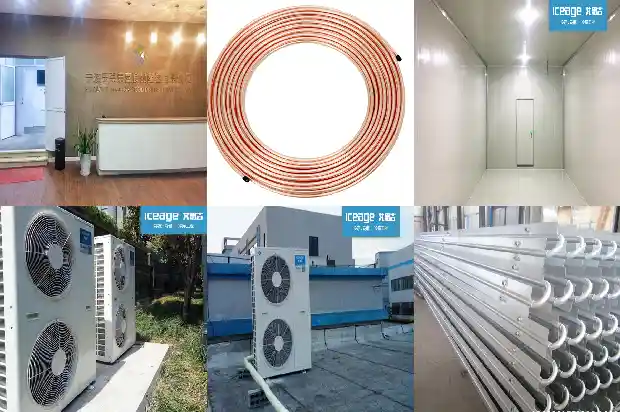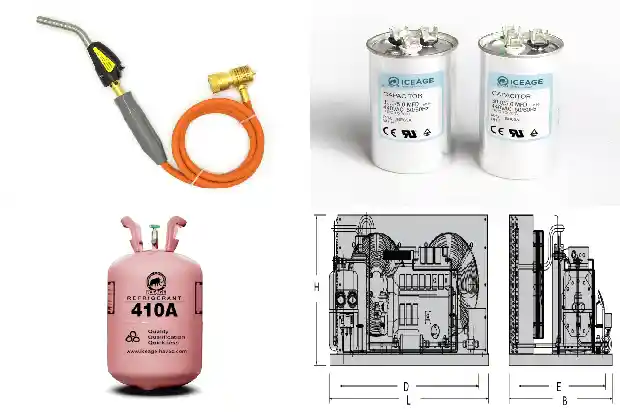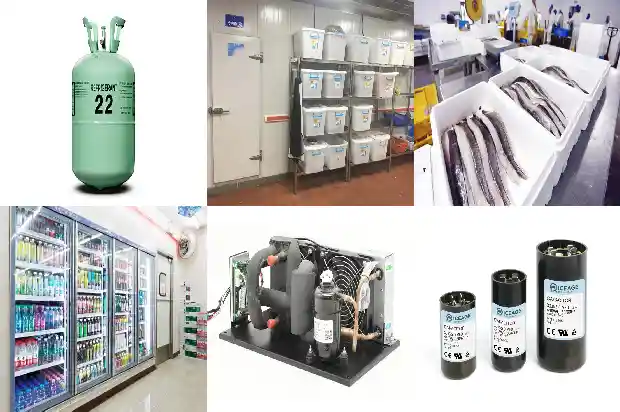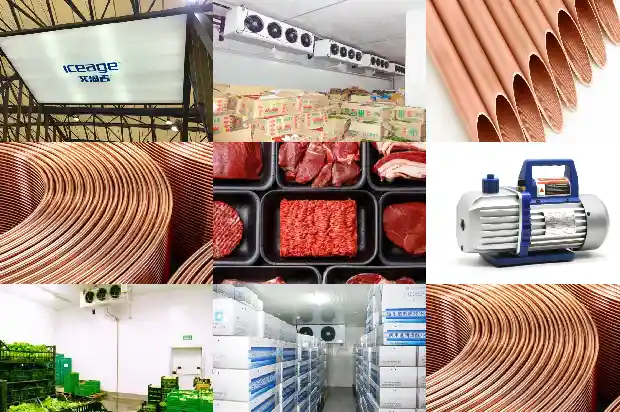These Inspections before Starting the Refrigeration Unit Are Very Important~~
2025-03-01
I. Inspections before Operation
The inspection before starting the refrigeration equipment is a crucial step related to the normal operation of the refrigeration equipment. Therefore, the operation and maintenance personnel should be particularly careful and meticulous during the inspection:
The inspection before starting the refrigeration equipment is a crucial step related to the normal operation of the refrigeration equipment. Therefore, the operation and maintenance personnel should be particularly careful and meticulous during the inspection:
- Whether the power supply voltage is within the range of 380V±5%.
- Whether the power supply and control switches are in the closed position.
- Whether the button switches and indicator lights on the panel of the electrical control cabinet are in good condition and indicating normally.
- Whether the controller display is normal, and whether there are any fault display barcodes or texts.
- Whether the oil level of the refrigeration unit is at the 1/2 position of the oil sight glass, and what the color of the oil is.
- Whether the oil temperature of the refrigeration unit is within the normal temperature range.
- Whether the high and low pressures of the refrigeration unit are balanced.
- Whether there are any leakage points at various parts of the refrigeration unit and the system.
- Check whether the valves at various parts of the refrigeration unit and the refrigeration system, including the cooling water system, are fully opened.
- Whether the liquid supply solenoid valve is working normally.
- Whether there are any abnormal noises in the coils of the evaporator system.
- Whether there are oil spots in the condensed water of the evaporator.
- Whether there are any abnormal noises when the evaporator fan is manually started.
- Whether the rotation direction of the evaporator fan is normal.
- Check whether the control panel of the refrigeration unit and various sensors and other components are in good condition.
- Confirm whether the set data of each item on the control panel of the refrigeration unit is correct.
- Check the historical fault records in the user menu.
- Check that there is no fault prompt on the control panel display.
- The compressor motor can be jogged first to see if it can be started, and whether there are any faults such as excessive starting current.
- Determine whether the rotation direction of the refrigeration compressor is correct. It is particularly important that the compressor must not rotate in reverse.
II. Inspection of Refrigeration Auxiliary Equipment
The inspection of refrigeration auxiliary equipment before starting is an important part related to whether the refrigeration equipment can operate normally for a long time. Therefore, the operation and maintenance personnel must conduct a particularly careful inspection: - Whether there is any water leakage in the cooling tower basin.
- Whether there is water in the cooling tower basin and whether the water level is normal.
- Whether the water distributor of the cooling tower is broken or detached.
- Whether the water quality of the cooling tower is normal.
- Whether there are any abnormal noises when the cooling tower fan is manually started.
- Whether the rotation direction of the cooling tower fan is correct.

- Whether the operating current of the cooling tower fan is normal.
- Whether there is water leakage at the packing of the cooling water pump, and whether all valves are open.
- Whether there are any abnormal noises when the cooling water pump is manually started.
- Whether the rotation direction of the cooling water pump is correct.
- Whether the operating current of the cooling water pump is normal.
- Whether the instruments of the cooling water pump system are damaged.

- Whether there are any water leakage points at various parts of the cooling water pump system.
- If it is an air-cooled condenser, check the rotation direction, rotation speed, current and voltage of the air-cooled condenser.
III. Starting the Refrigeration Equipment
Before the official start-up, please confirm the above contents again: - Press the compressor start button, and then the cooling water pump will start to run. Please check in time whether the operating voltage and starting current of the cooling water pump are normal. Immediately afterwards, check whether the inlet and outlet pressures of the cooling water pump are normal. Whether the liquid supply solenoid valve is opened, and the R22 liquid supplies liquid to the evaporator in the system through the thermal expansion valve.
After a few seconds, when the suction pressure rises back to a certain value, the compressor will make a kind of movement sound, and the compressor starts. The starting current of the compressor is 2 times the rated current of the motor, and it will instantly turn into the rated current of the normal compressor motor.
- When the compressor is operating normally, the compressor oil heater will stop running, and the indicator light of the electric heater will go out.
- After the compressor runs, the coils or air coolers in the storage room will start to operate and begin to cool down.
- When the cooling water temperature reaches 25℃ (here, refer to the set temperature), the cooling tower fan will automatically start to run, forcing air convection to reduce the temperature of the cooling water. At this time, the operator needs to determine whether the operating voltage, operating current and the running sound of the fan are normal.

- When the compressor is fully running, it is necessary to confirm the operating voltage, operating current and the running sound of the compressor. The fully automatic unit runs one compressor at the beginning. When the refrigerating capacity of the compressor cannot meet the external energy demand, the CPU will issue an instruction to start the second compressor to achieve the purpose of dual-machine operation.
- If the machine is a refrigeration compressor unit with two compressors, one compressor is started at the beginning of operation. When the temperature sensor on the computer board detects that the temperature curve does not show a cooling trend, the computer will drive the second compressor to start running. When the temperature of the refrigeration system reaches the set requirement, the CPU will unload one compressor from operation. When the temperature of the storage room completely reaches the set temperature, the CPU will command the first compressor to stop working and be in standby mode. When the temperature of the second operation is higher than the set temperature of the room, the CPU will first start the first compressor to run.
- After the compressor system is operating normally, the operator needs to confirm the exhaust pressure, exhaust temperature, return gas pressure, return gas temperature, compressor oil pressure, oil temperature, oil level (the oil level should not be lower than 1/3 of the oil cup), oil color, the inlet water temperature of the condenser, and the outlet water temperature of the condenser of the compressor. All the above technical indicators should be within the normal operating range of the compressor.
- After the compressor runs for a period of time, observe the cooling speed of the temperature in the storage room. A fast cooling speed in the storage room indicates that the refrigerating capacity of the refrigeration compressor is large, and the fan stirs the air flow in the storage room more fully. In addition, check whether there is any vibration sound in the coil box, whether there are any abnormal noises in the air cooler and whether the rotation direction of the fan is correct, and whether there is any backflow phenomenon in the condensate pipe.
- When the temperature of the storage room is close to the set value and the refrigeration compressor is running at full load, the system evaporation temperature, the air outlet temperature of the fan coil, and the liquid flow situation in the liquid supply sight glass should be checked.
- When the refrigeration compressor cools down the storage room, when the operation cycle of the compressor switches from one cycle to another, the operator needs to determine the on-off cycle time of the compressor and it is best to record it.
Related Articles
- What inspections are required for central air conditioning installation?
- Common Fault Causes of Totally Enclosed Refrigeration Compressors
- Popularize Refrigeration Knowledge You've Never Noticed, Which Is Actually Very Crucial
- Analysis of Common Auxiliary Components in the Refrigeration System
- Does the Refrigeration System Definitely Need to Be Evacuated? What Will Happen If It Isn't?
- Common Faults in Refrigeration Systems and Handling Methods
- Why Should Refrigeration Shut - off Valves Have "Low - Inlet and High - Outlet" Design?
- Four Requirements for Refrigeration Systems Adopting Two - stage Compression Refrigeration Systems
- Screw Compressor Units: Principles, Design and Selection - Essential Guide for Refrigeration Beginners
- Don't Overlook: The Impact of Capillary Tube Length on Refrigeration System Parameters
- Refrigeration Repair Techniques: A Must - Know - "Sub - cooling" and "Super - heating"
- What Impact Does Pressure Have on the Refrigeration System?
- Advanced Guide! Design and Installation of Refrigeration System Pipelines
- Defrosting Heating Tubes in Refrigeration Devices
- Refrigeration Components of Refrigeration
- Refrigeration System: Copper Pipe Welding and Flushing Operations
- Have You Encountered the Three Common Problems of Refrigeration Compressors?
- How to Calculate Refrigeration Load? And What Are the Issues?
